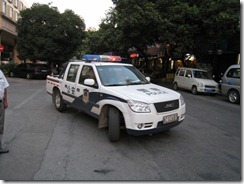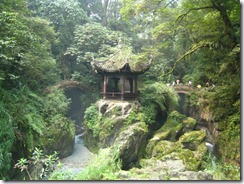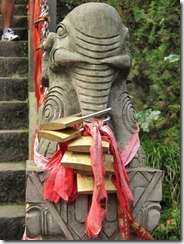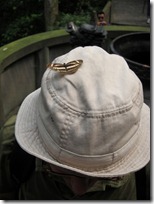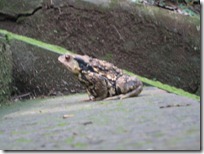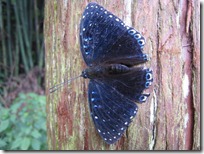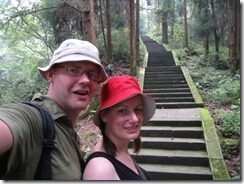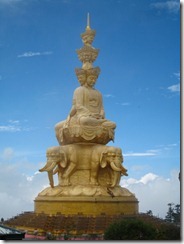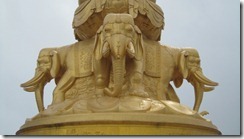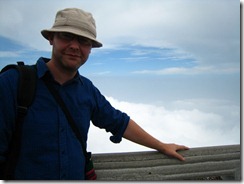Welcome to Hong Kong?
Hong Kong – our last stop. The End. The Big Finish. The rousing chorus of Rule Britannia at the end of the evening. The fireworks display at midnight. The last gong from Big Ben. Or, in our case, the 10% service charge you didn’t know you were paying that takes the shine off the lovely meal you’ve just had.
I’ve been to Hong Kong once before but, strangely, don’t remember a lot about it. I do remember really liking it though and thinking it would be great to come back here and, being a student at the time, preferably with a bit of money in my pocket cos Hong Kong has got to be one of the most expensive places in the world. I also agree with the Lonely Planet, that everyone should stay at the Peninsula Hotel at least once in their lives. Unfortunately, the cheapest room there is £400 a night, so that was somewhat out of the budget this time, but the plan was to treat ourselves a little bit and stay somewhere a bit nicer than the hostels in China, after three weeks of trundling from place to place.
I’m too old for the likes of Chunking Mansions and am just not into the backpacker thing any more, so the search began for a mid-range hotel back in July some time, somewhere a bit more expensive so that we could have a really nice last 2 days, with a teeny tiny bit of luxury. Finding a hotel was a nightmare – I didn’t know where to start looking, asked for advice from everyone I knew but the sort of thing I was looking for was turning out to be a lot more expensive than I’d planned. There’s every kind of hotel for every price you can imagine in Hong Kong so my worry was that we’d end up paying over the odds for something that just wasn’t worth it but to be sure of the getting something really good we’d have had to spend more than we wanted to. I wanted to find somewhere affordable where you got as much as possible for your money. In the end, the trusty old Lonely Planet came to the rescue again, picking out the Minden as their special recommendation. Here’s what it says:
“The boutique-ish Minden is a welcome injection of charisma to Hong Kong's midrange hotel gang. Packed with Asian and Western antiques, curios and furnishings, it's an eclectic mix that works.”
Sounds good, right?
Imagine my horror, then, when we checked into our room to find…the same hotel room you would see in any Travelodge/Holiday Inn Express/No Name Motel anywhere else in the world. Beige walls (Where’s the charisma?). Non-descript furniture (Where were the curios?). And a god-awful smell (Maybe this was the eclectic bit?). I thought it smelled as if something had died under the bed, Gav thought it smelled of damp. We were on the 17th floor so that would be some damp, but whatever it was, it was deeply unpleasant. Welcome to Hong Kong!
It’s hot in Hong Kong most of the year round and water is a must at all times. Throughout our trip, all but one hostel provided bottled water for free. I wouldn’t expect such frivolity in Hong Kong – they’d charge you for the oxygen you’re breathing if they could, but I did feel that £6 for the bottle of water placed in each room was a bit steep. Was it special holy water? Hand squeezed from the rocks on Hong Kong Island by virgin princesses? I doubt it.
After a very smelly night, we decided to ask to change rooms. The decidedly personality-free receptionist click-clicked around on her computer only to tell us they were full, so no room change possible. However, I’d checked on the internet and knew that there WERE rooms available in the next price bracket (an extra tenner on what we were paying, going from a standard to a deluxe double). I’d have expected her to upgrade us at no extra charge. Or a discount, maybe? Silly me! No such offer ensued and we were stuck with our stinky quarters. Welcome to Hong Kong!
On arrival, we were given a little card that said, “Welcome to the Minden. Please go to our bar to claim a complimentary welcome drink.” Finally, we thought. Something approaching service. So off we went to claim our drink before heading out for dinner. The barman was very attentive and explained that we could have the house red, the house white, beer or soft drinks. We opted for a nice cool Tsing Tao beer each and weren’t greatly surprised when we were handed the teeniest bottles of beer possible, but hey, it was free, right? Cheers and here’s to a nice evening. Beers downed, we were ready to head into the city to explore the harbour and find something scrummy to eat.
My heart sank when the barman stopped us leaving and said, “Sorry, you have to pay.” “??? The card says free drink. Is there a service charge?” “No, madam. The card entitles you to one free drink. You had two.” Silly old me for presuming that when booking a double room for two people and you’re handed a card saying you can have a free drink that you might be entitled to a drink EACH rather than having to share a 200ml bottle of beer between us! A 200ml bottle of beer at the bargain price of £5.50. Thanks. That makes me feel really warm and cuddly inside. Welcome to Hong Kong!
Hong Kong now had a lot of grovelling to do so we headed down to the harbour, which is a pretty spectacular sight during the day but just impossibly romantic and wonderful at night. At 8pm every night, Hong Kong does a bit of a display in the harbour – something like the biggest permanent light installation in the world. We could expect a huge show, apparently, with lights and pictures projected onto the buildings on the Kowloon side from the Island. We picked a spot on the harbour to sit, lots of other people were there for the same thing and there was a hint of excitement in the air. As we drew nearer to 8pm, the street lights on our side dimmed slightly to an “oooooh” that rippled through the crowd. Here we go.
8pm – several buildings on the Island switch off their lights. The street lights on our side go off. The tension mounts. Cue tinny speakers with dramatic drum rolls and music, welcoming us to…the Symphony of Light! Fairly naff Chinese music pipes in and the buildings across the harbour start vaguely flashing in time with the various peaks and falls in the hum. Ooh, look, a green laser from the top of the Bank of China building (the impressive triangular one with antennae on top). Ooh, another green laser. I kept turning around to see the marvellous projections on the buildings behind us. Except there weren’t any. Bloody Lonely Planet – I’m starting to think they just make it up. The music was starting to grate a little now and the buildings across the harbour were just sparkling slightly more furiously than they normally do, with no sense of drama, or building up to a climactic finish. Very Chinese, not very Hong Kong. To be honest, the harbour’s a more impressive sight without the amateur dramatics. Welcome to Hong Kong!
One of the big attractions in Hong Kong is obviously the shopping. We’d seen various bits and bobs throughout our travels, but most of the stuff you can buy in China is tat. Of the most spectacular kind. We’d seen some really good fakes in Beijing but had decided to wait till Hong Kong to buy stuff so that we didn’t have to lug everything around for 3 weeks. Hong Kong’s markets are legendary! I particularly had my eye on a fake Longchamp handbag or three. I’m not into designer labels at all – in fact, until I tried to buy myself a Longchamp bag having seen someone on the tube with one and thinking, ooh, that’s practical, I didn’t even know they WERE designer – but I do like handbags. Especially if you can buy them in lots of different colours. And sizes. We saw hundreds of the bloody things in Beijing but, like I said, Hong Kong was easier.
‘Cept none of the bloomin’ markets there had any, did they!! I did spot some on one stall, but the fakers were so lack-lustre that they couldn’t be bothered to try and get the zip fastening right and just bunged any old one on there. I may not be into designer stuff, but if I’m going to buy a fake, I’d prefer it was a good one. I dragged poor Gavin around more markets than is strictly necessary throughout our two days in Hong Kong and there wasn’t a single Longchamp in sight. Nor was there much else. Finally, in Stanley Market, I found a lovely, friendly stall holder who said they had Longchamp, but in their other shop just down the alley. So off I trotted and lo and behold, there was a small selection of handbags. And they had a 2 for 1 offer on. Bargain. Except these stall holders refused to bargain, no matter how hard I tried and were generally extremely unpleasant. “No! It’s buy one get one free today. No bargain.” “But you’re charging 30 quid for them. That’s almost what they cost when they’re real! They cost a fiver in Beijing!!!” “Buy one get one free, take it or leave it.” And they didn’t even have the colours I wanted. Or the sizes. Harrumph. I should have left it but I hadn’t traipsed all around Hong Kong to leave empty handed! I am now the proud owner of two fairly poorly faked, overpriced Longchamp handbags. Welcome to Hong Kong!
So basically, Hong Kong = a bit of a disappointment. However, there were some good bits, so I’ll put those in a nice, shiny, clean, new post, where they can’t be contaminated by the crappiness mentioned here! ![]()
![IMG_7441 (2) (480x640)[4] IMG_7441 (2) (480x640)[4]](http://lh3.ggpht.com/_-dcc8vgPCGM/TcCFwGGW4CI/AAAAAAAAAOg/CkQcXpJ5HUc/IMG_7441-2-480x6404_thumb.jpg?imgmax=800)
![IMG_3258 (480x640)[4] IMG_3258 (480x640)[4]](http://lh4.ggpht.com/_-dcc8vgPCGM/TcCFxX9m0bI/AAAAAAAAAOo/eUXH2as85NU/IMG_3258-480x6404_thumb.jpg?imgmax=800)
![IMG_3250 (640x480)[4] IMG_3250 (640x480)[4]](http://lh6.ggpht.com/_-dcc8vgPCGM/TcCFyXk0dTI/AAAAAAAAAOw/eWBabHtqMeo/IMG_3250-640x4804_thumb.jpg?imgmax=800)
![IMG_3255 (480x640)[4] IMG_3255 (480x640)[4]](http://lh6.ggpht.com/_-dcc8vgPCGM/TcCFzoAX8pI/AAAAAAAAAO4/uuwLc1KbzaU/IMG_3255-480x6404_thumb.jpg?imgmax=800)
![IMG_7449 (2) (640x480)[4] IMG_7449 (2) (640x480)[4]](http://lh5.ggpht.com/_-dcc8vgPCGM/TcCF0t_GH5I/AAAAAAAAAPA/hgluEox5A5U/IMG_7449-2-640x4804_thumb.jpg?imgmax=800)
![IMG_3256 (640x480)[6] IMG_3256 (640x480)[6]](http://lh3.ggpht.com/_-dcc8vgPCGM/TcCF11njDCI/AAAAAAAAAPI/1WPUPo4Ikeg/IMG_3256-640x4806_thumb.jpg?imgmax=800)
![IMG_3252 (480x640)[5] IMG_3252 (480x640)[5]](https://blogger.googleusercontent.com/img/b/R29vZ2xl/AVvXsEifUVpcPyz-N9j28m6NGkyQI4s6ZJ3jnCCNbTJ2yFllJQPG5MbHSU4WQqlUsORvTImOyfo3geJtLqBCKtEVuv1rNSQxuitWtf0z7HVtG4KC1EckZAaEacXLMCYuVXX64YKhUFLx/?imgmax=800)
![IMG_3251 (640x480)[5] IMG_3251 (640x480)[5]](http://lh6.ggpht.com/_-dcc8vgPCGM/TcCF38OmJcI/AAAAAAAAAPY/2amX24zgMxA/IMG_3251-640x4805_thumb.jpg?imgmax=800)
![IMG_3261 (480x640)[5] IMG_3261 (480x640)[5]](http://lh3.ggpht.com/_-dcc8vgPCGM/TcCF4xFPlMI/AAAAAAAAAPg/NmNhTfY4LEY/IMG_3261-480x6405_thumb.jpg?imgmax=800)
![IMG_7451 (2) (640x480)[4] IMG_7451 (2) (640x480)[4]](http://lh5.ggpht.com/_-dcc8vgPCGM/TcCF6l2Kk4I/AAAAAAAAAPo/DfDl2o_1FUo/IMG_7451-2-640x4804_thumb.jpg?imgmax=800)
![IMG_7461 (2) (480x640)[4] IMG_7461 (2) (480x640)[4]](https://blogger.googleusercontent.com/img/b/R29vZ2xl/AVvXsEi2zX1Hsi5K99P5ayAGsfoZFJbixjHKNskb9uWd_2N8ftsM5aXK71vM2TrVjmnVnWorHHFaW9y1ctBbEl39m__FT7OxR5BfFeTc5hArlei26IkiH6ZvElrqs8C1GwvsQVpTmqE9/?imgmax=800)
![IMG_7462 (2) (640x480)[4] IMG_7462 (2) (640x480)[4]](http://lh4.ggpht.com/_-dcc8vgPCGM/TcCF82AI_EI/AAAAAAAAAP4/IvaP14gQ1S8/IMG_7462-2-640x4804_thumb.jpg?imgmax=800)
![IMG_3268 (640x480)[4] IMG_3268 (640x480)[4]](http://lh4.ggpht.com/_-dcc8vgPCGM/TcCF-QyGasI/AAAAAAAAAQA/2NC__N-3FCA/IMG_3268-640x4804_thumb1.jpg?imgmax=800)
![IMG_7421 (2) (480x640)[4] IMG_7421 (2) (480x640)[4]](https://blogger.googleusercontent.com/img/b/R29vZ2xl/AVvXsEg-3QqRRqC4qdWBaJuZRoKaO4gGmM6ExFfHO_s6PE0xDtDqkUNmpQqNgwAahW5qaXfoeZ4OcJR7L4fnbGOUP04VO67ymrSO7Vwa926TY8wFEHiUDbZ69VAL-c__Cvp8Gck_hk0T/?imgmax=800)
![IMG_7423 (2) (480x640)[4] IMG_7423 (2) (480x640)[4]](http://lh6.ggpht.com/_-dcc8vgPCGM/TcBBRIg5cUI/AAAAAAAAALs/nfpUCd58N6M/IMG_7423-2-480x6404_thumb.jpg?imgmax=800)
![IMG_3241 (640x480)[4] IMG_3241 (640x480)[4]](http://lh4.ggpht.com/_-dcc8vgPCGM/TcBBSeTuO8I/AAAAAAAAAL0/UkRM2vxI30Y/IMG_3241-640x4804_thumb.jpg?imgmax=800)
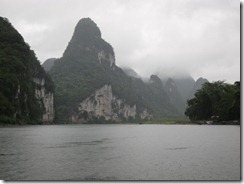
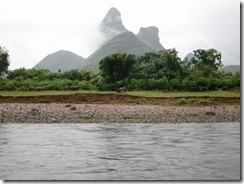

![IMG_7397 (2) (640x480)[4] IMG_7397 (2) (640x480)[4]](http://lh5.ggpht.com/_-dcc8vgPCGM/TcBDEOUklGI/AAAAAAAAANY/WYVkgGcHIZo/IMG_73972640x4804_thumb.jpg?imgmax=800)
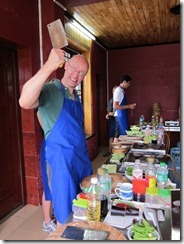

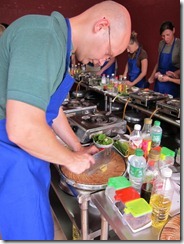
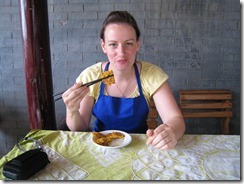
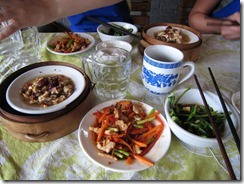
![IMG_7383 (2) (640x480)[4] IMG_7383 (2) (640x480)[4]](http://lh3.ggpht.com/_-dcc8vgPCGM/TcBAtZzVZAI/AAAAAAAAAKg/TC1OTGm7CYs/IMG_73832640x4804_thumb1.jpg?imgmax=800)
![IMG_3204 (640x480)[4] IMG_3204 (640x480)[4]](http://lh3.ggpht.com/_-dcc8vgPCGM/TcBAu_c_TKI/AAAAAAAAAKs/lbcyJxN9hXE/IMG_3204640x4804_thumb.jpg?imgmax=800)
![IMG_7355 (2) (640x480)[4] IMG_7355 (2) (640x480)[4]](http://lh6.ggpht.com/_-dcc8vgPCGM/TcBAv6rq3ZI/AAAAAAAAAK0/xps4by-23Lo/IMG_73552640x4804_thumb.jpg?imgmax=800)
![IMG_7361 (2) (640x480)[4] IMG_7361 (2) (640x480)[4]](https://blogger.googleusercontent.com/img/b/R29vZ2xl/AVvXsEj10Ci_lUInWzmBWLA7ZD-mKyg81SJR7S2DTvQoRyTwBnTZV8Zc-ndtNa1l3a927va2Sp_fpwcTiZQG24uxCmMjySL2d9tKvHZD1eVp79HCfc-2-deEs902OI2WWSvg5LbvOGAY/?imgmax=800)
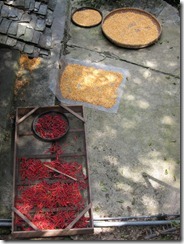



![IMG_3205 (640x480)[4] IMG_3205 (640x480)[4]](http://lh4.ggpht.com/_-dcc8vgPCGM/TcCFfkaVZEI/AAAAAAAAAOI/3yxWF2XWxz8/IMG_3205640x4804_thumb.jpg?imgmax=800)

